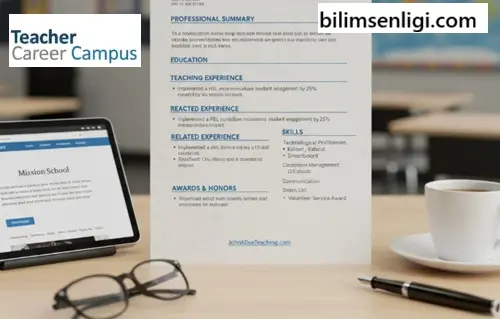Teaching is undoubtedly one of the most vital and rewarding professions in the world. However, this noble duty also comes with heavy responsibility and an intense workload. As an educator, the ability to balance your professional responsibilities with maintaining a healthy personal life is not just a skill—it is the key to a long and sustainable career. This is where work-life balance comes into play.
A good work-life balance reduces stress, boosts your productivity, and increases job satisfaction, which directly and positively contributes to your overall quality of life. Cultivating a balanced mindset not only helps you in your current role but also makes you a highly sought-after candidate for future employers.
In this article, we will delve deeply into how to establish work-life balance as a teacher, offering valuable, practical tips to guide you through your career journey.
Defining Work-Life Balance for Educators
For educators, work-life balance refers to the skill of establishing equilibrium between professional responsibilities (lesson planning, grading, parent communication) and personal life (self-care, hobbies, spending time with family and friends).
As teachers, you can easily find yourselves under an excessive workload, ranging from grading assignments outside of school hours to preparing weekly lessons. The goal is to strike a balance between the two, preventing one from entirely overshadowing the other. Achieving this balance improves job performance, strengthens mental health, and minimizes the common risk of burnout prevalent in the education sector.
How to Achieve Work-Life Balance as a Teacher
Here is a list of proven strategies you can apply to maintain that fine line between work and personal life:
- Prioritize Your Health: You Cannot Pour From an Empty Cup
You are the most important resource for your students. Remember, you cannot pour from an empty cup. Teachers often tend to prioritize the needs of their students over their own, but to sustain your health, you must first attend to your physical, mental, and emotional well-being.
- Physical Needs: Regular exercise, a balanced diet, and most crucially, sufficient sleep form the foundation of your energy levels.
- Mental Well-being: Mindfulness practices like meditation can significantly contribute to your mental health and stress management. These moments dedicated to yourself ensure you return to work more focused and ready.
- Manage Time Effectively and Stay Organized
Being organized is the key to a balanced lifestyle.
- Set Dedicated Time Blocks: Plan your week in advance by setting specific time blocks for lesson planning, assessment, and grading. This prevents work from spilling over into your personal time.
- Utilize Digital Tools: Use digital calendars and planning apps to keep your schedule accessible at all times and track deadlines.
- Establish and Maintain Boundaries
Creating clear boundaries between work and personal life is perhaps the most critical element of work-life balance.
- Define a Stop Time: Set a schedule for when you start and when you finish work each day. Implement a rule like, “No grading after 6 PM.”
- Manage Communication: Ensure your colleagues, students, and parents respect this boundary. Not responding to non-urgent messages outside of work hours is a crucial part of this boundary.
- Create “Me” Time: Use the time outside your boundary to relax, engage in hobbies, or spend time with family and friends.
- Learn to Delegate and Share
It is natural for an educator to take ownership of all tasks, but some duties can easily be delegated or shared among colleagues.
- The Power of Collaboration: Creating lesson plans as a team, dividing up grading, or jointly developing classroom resources reduces individual workload while fostering a collaborative environment. Remember, the burden lightens when shared.
- Seek Support When Needed and Embrace Continuous Development
When you are struggling, do not hesitate to ask for help. This is a sign of awareness, not weakness.
- Professional Support: Whether it is seeking guidance from a mentor, pursuing professional counseling, or simply venting to a fellow teacher, remember that you are part of a community that can provide much-needed emotional support.
- Continuous Professional Development (CPD): Learning new strategies to cope with work-related tension is a key part of professional growth. Courses on stress management, time management, or new teaching methodologies will help you advance better in your career.
The Impact of Work-Life Balance: Teaching Effectiveness and School Culture
Impact on Teaching Effectiveness
Teachers who maintain a healthy balance are less likely to suffer from burnout or stress-related illnesses.
- They are typically more present, energetic, and engaged in their classes.
- They are better prepared to handle unexpected situations and more likely to express job satisfaction.
- They serve as positive role models for their students, demonstrating how to effectively balance various life demands.
The Role of School Culture and Leadership Support
A school’s culture can directly influence a teacher’s work-life balance.
- Balance-Supportive Schools: Schools that promote a healthy work-life balance and invest in teacher well-being increase job satisfaction and reduce staff turnover rates.
- Leadership’s Role: Administrators can help create a healthier work environment by implementing policies that support balance, such as limiting after-school meetings, offering professional development opportunities related to stress management, and encouraging the use of personal days for mental health. Fostering a culture where teachers’ work is acknowledged and appreciated also contributes positively to balance.
The Double-Edged Sword of Technology
Technology can be both a helper and a challenge when it comes to work-life balance for teachers.
- Efficiency Boost: Digital tools like online lesson planning, communication apps, or digital assignment platforms can save time and increase efficiency.
- Blurred Boundaries: However, if not managed effectively, the same technology can blur the line between work and personal time. Simple steps like turning off email notifications or removing work apps from your personal phone can make a huge difference.
Challenges Vary by Experience Level
The challenges faced while striving for work-life balance can vary depending on a teacher’s experience level:
- Novice Teachers: New teachers, who are still learning the ropes, may struggle with effective time management and might feel compelled to work extra hours for planning or grading.
- Experienced Teachers: Experienced teachers, on the other hand, may face higher expectations due to their competence, leading to a greater workload. The need to adapt to technological advancements can also require additional learning time.
Ultimately, every unique situation demands specific strategies to maintain individual work-life balance.
Work-life balance is not a destination but a continuous journey. To be the best educator for your students, you must first take good care of yourself. Remember, your well-being is their success.
What practical steps are you taking to protect your own work-life balance? We’d love to hear your thoughts!





